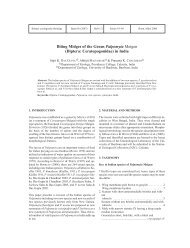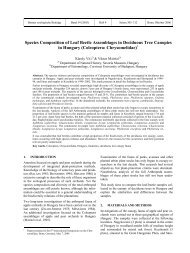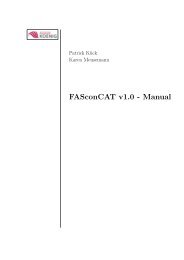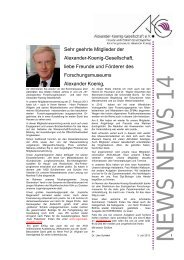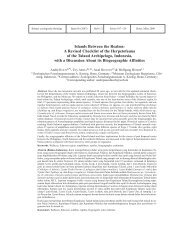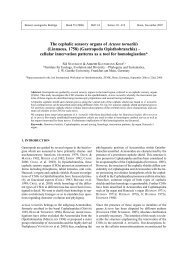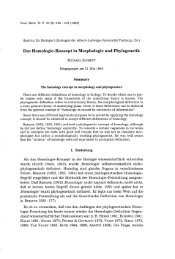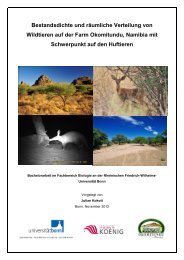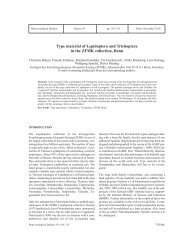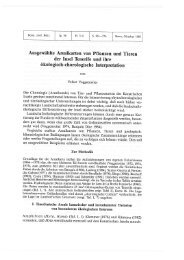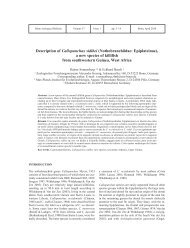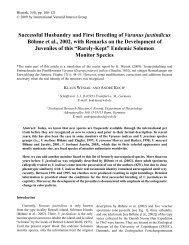Biogeography of the Sacoglossa (Mollusca, Opisthobranchia)*
Biogeography of the Sacoglossa (Mollusca, Opisthobranchia)*
Biogeography of the Sacoglossa (Mollusca, Opisthobranchia)*
You also want an ePaper? Increase the reach of your titles
YUMPU automatically turns print PDFs into web optimized ePapers that Google loves.
260 Ka<strong>the</strong> R. JENSEN: <strong>Biogeography</strong> <strong>of</strong> <strong>Sacoglossa</strong><br />
tributions (SCHMEKEL & PORTMANN 1982; THOMPSON<br />
1988). Eight amphi-Atlantic (one <strong>of</strong> which may be cosmopolitan),<br />
eight Nor<strong>the</strong>ast Atlantic-Lusitanian, and five<br />
endemic species do not extend into <strong>the</strong> eastern basin <strong>of</strong><br />
<strong>the</strong> Mediterranean. Only four species found in <strong>the</strong> eastern<br />
basin <strong>of</strong> <strong>the</strong> Mediterrnanean do not occur in <strong>the</strong> western<br />
basin; two <strong>of</strong> <strong>the</strong>se have been described recently<br />
(THOMPSON 1988). The total number <strong>of</strong> sacoglossans in<br />
<strong>the</strong> eastern basin is only 17 whereas 34 species are known<br />
from <strong>the</strong> western basin (SW E N N E N 1961; BA R A S H & DA N I N<br />
1971; SCHMEKEL & PORTMANN 1982; THOMPSON 1983;<br />
BOUCHET 1984; THOMPSON et al. 1985; THOMPSON 1988;<br />
THOMPSON & JAKLIN 1988; CATTANEO-VIETTI & THOMP-<br />
S O N 1989; CE RV E R A et al. 2006). The sou<strong>the</strong>rn coast <strong>of</strong> <strong>the</strong><br />
Mediterranean has been insufficiently studied. It is uncertain<br />
whe<strong>the</strong>r two or three species extend into <strong>the</strong> Black<br />
and Azov Seas. Limapontia capitata and Calliopaea bel -<br />
lula (as Stiliger bellulus) have been recorded previously<br />
(MURINA & ARTEMJEVA 1997), but recent pictures on <strong>the</strong><br />
Sea Slug Forum (KU R A K I N 2002) have shown that E rc o l a -<br />
nia viridis is present, and it remains to be seen whe<strong>the</strong>r<br />
<strong>the</strong> species previously identified as C. bellula has been<br />
misidentified, or whe<strong>the</strong>r both species occur.<br />
The Lusitanian and Mediterranean provinces have very<br />
high similarity indices (Table 3). The combined number<br />
<strong>of</strong> species amounts to 52, which is very close to <strong>the</strong> species<br />
diversity found in <strong>the</strong> Caribbean. However, <strong>the</strong> number<br />
<strong>of</strong> Plakobranchidae is lower in <strong>the</strong> eastern Atlantic<br />
provinces (Table 9).<br />
BRIGGS (1995) recognizes one circumpolar Arctic region<br />
comprising Spitzbergen, Greenland and <strong>the</strong> nor<strong>the</strong>rn<br />
coasts <strong>of</strong> North America and Russia. No sacoglossans have<br />
been recorded from Spitzbergen (GULLIKSEN et al. 1999)<br />
or <strong>the</strong> north coast <strong>of</strong> North America (BLEAKNEY 1996;<br />
GODDARD & FOSTER 2002). The four species occurring in<br />
<strong>the</strong> White Sea also occur in <strong>the</strong> Russian part <strong>of</strong> <strong>the</strong> Barents<br />
Sea (ROGINSKAYA 2000; MARTYNOV et al. 2006). In<br />
addition, MARTYNOV et al. (2006) mentions an old record<br />
<strong>of</strong> a single juvenile specimen <strong>of</strong> Placida dendritica from<br />
Kola Bay. This indicates that this area is influenced by <strong>the</strong><br />
North Atlantic Current and should be included in <strong>the</strong> boreal<br />
region. The single specimen <strong>of</strong> Alderia modesta<br />
recorded from western Greenland (PL AT T S 1985) could be<br />
attributed to larvae transported from Canada, which may<br />
occasionally be able to find suitable habitats for metamorphosis<br />
in Greenland. The latitude <strong>of</strong> Disko Fjord is about<br />
<strong>the</strong> same as nor<strong>the</strong>rn Norway, where <strong>the</strong> species occurs<br />
r e g u l a r l y. It should be mentioned that in Danish waters this<br />
species seems to have disappeared from localities where<br />
prior to 1997 it was abundant (pers. obs.). Whe<strong>the</strong>r this<br />
is due to habitat deterioration or increased temperature is<br />
unknown.<br />
The fauna <strong>of</strong> <strong>the</strong> Northwest Atlantic is also very well studied<br />
(e.g. MARCUS & MARCUS 1970; MARCUS 1972a,b;<br />
MARCUS & HUGHES 1974; CLARK 1975; JENSEN & CLARK<br />
1983; BLEAKNEY 1996), though new species are still being<br />
described from <strong>the</strong> tropical waters (ORT E A & ES P I N O S A<br />
1996, 2000, 2001, 2002; CABALLER et al. 2006; PIERCE et<br />
al. 2006). Only 6 species occur in <strong>the</strong> cold temperate<br />
province; one <strong>of</strong> <strong>the</strong>se, Placida dendritica, may be cosmopolitan<br />
(BL E A K N E Y 1989) and one, Alderia modesta, is<br />
circum-boreal. Apparently only one species, Elysia catu -<br />
lus, is endemic to <strong>the</strong> Northwest Atlantic cold water region<br />
(CLARK 1975). This species feeds on <strong>the</strong> seagrass<br />
Zostera marina, which does not occur in Florida. It is possible<br />
that E. catulus is a dark pigmented variety <strong>of</strong> <strong>the</strong> o<strong>the</strong>r<br />
seagrass feeding species, Elysia serca (JENSEN 1982),<br />
in which case <strong>the</strong>re will be no endemic species for <strong>the</strong><br />
Northwest Atlantic. E rcolania fuscata may occur from Nova<br />
Scotia, Canada to Sao Paolo, Brazil, but this distribution<br />
is based on synonymization with E. vanellus and E.<br />
t a l i s (JE N S E N & CL A R K 1983). Two species, Elysia chloro t -<br />
ica and Hermaea cruciata, have <strong>the</strong>ir sou<strong>the</strong>rn limit in<br />
Florida (JENSEN & CLARK 1983), i.e., just south <strong>of</strong> <strong>the</strong><br />
cold-water region. The former species also occurs in <strong>the</strong><br />
nor<strong>the</strong>rn part <strong>of</strong> <strong>the</strong> Gulf <strong>of</strong> Mexico (BOONE 1982), and<br />
<strong>the</strong> latter has its nor<strong>the</strong>rn limit in Massachusetts (MAR-<br />
CUS 1972a). The species presently known as Limapontia<br />
zonata, and known only from its original collection<br />
(GOULD & BINNEY 1870), is probably a flatworm; no<br />
sacoglossan has transverse pigment bands.<br />
A separate Carolinian province could not be distinguished<br />
for sacoglossan opisthobranchs, and no difference is evident<br />
between <strong>the</strong> continental and insular parts <strong>of</strong> <strong>the</strong><br />
Caribbean (CLARK & DEFREESE 1987), including Bermuda<br />
(CLARK 1984), although <strong>the</strong>se provinces were considered<br />
distinct by BRIGGS (1995). However, <strong>the</strong> majority <strong>of</strong><br />
studies involving sacoglossans are from <strong>the</strong> Caribbean islands.<br />
The limit between cold-water and tropical faunas<br />
appears to be along <strong>the</strong> coast <strong>of</strong> Florida (JE N S E N & CL A R K<br />
1983); 36 <strong>of</strong> <strong>the</strong> 49 Caribbean species have been recorded<br />
from Florida (THOMPSON 1977; MARCUS 1977, 1980;<br />
CLARK 1982; CLARK & DEFREESE 1987; PIERCE et al.<br />
2006; VA L D É S et al. 2006). The degree <strong>of</strong> endemism in <strong>the</strong><br />
Caribbean is exceptionally high (Table 2). Especially <strong>the</strong><br />
number <strong>of</strong> Plakobranchidae is high (Table 9), indicating<br />
that speciation in this family has taken place within <strong>the</strong><br />
province. Five <strong>of</strong> <strong>the</strong> 21 endemic species have been described<br />
after 1990, so <strong>the</strong>y may be found outside this<br />
province in <strong>the</strong> future or be synonymized with o<strong>the</strong>r<br />
species. As for <strong>the</strong> Mediteranean and Lusitanian provinces,<br />
synonymies are extensively debated and <strong>the</strong> status <strong>of</strong> several<br />
species remains uncertain (JENSEN & CLARK 1983;<br />
MARCUS 1980; VALDÉS et al. 2006).




